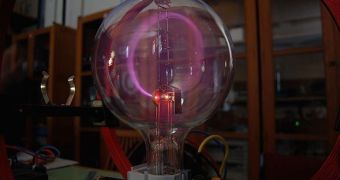Scientists at the Boston College recently announced that they managed to devise a new type of very thin solar cells, which are able to harvest the energy stored in so-called “hot electrons.” These particles are generated as free electrons, when photons making up light are captured by the components of regular solar films. The thing about the “hot” variety is that it has a relatively small life time, and also the fact that most of its energy is lost as heat before it can be captured.
But the new design was apparently able to get past these obstacles, and provide a way for these stray elementary particles to be captured as well. In order for them to be of any use, they have to reach the bottom of the conduction band, the researchers say, but that proved to be very difficult to accomplish with thicker solar-film designs. The new system captures the charges before their vast majority is lost as heat along the way. Details of the amazing, new work appear in the current online issue of the respected scientific journal Applied Physics Letters.
The hot electrons, also known as hot carriers, can be observed in semiconductors as well. The problem is that they have so much energy that they can affect the good functioning of the hardware itself. As soon as scientists became aware of these energies that they were missing out on, they set out to create ways of capturing them via solar cells, in what have since become known as “3rd generation” devices. The new achievement was only made possible by an extremely thin film, measuring less than 30 nanometers in thickness.
The lead author of the new paper, BC Professor of Physics Krzysztof Kempa, says that what he and his team did was basically minimize the environment in which the electrons moved. The direct effect was that they had a lot smaller distance to travel, and therefore lost less energy as heat. “We have shrunk the size of the solar cell by making it thin. In doing so, we are bringing these hot electrons closer to the surface, so they can be collected more readily. These electrons have to be captured in less than a picosecond, which is less than one trillionth of a second,” Kempa says.

 14 DAY TRIAL //
14 DAY TRIAL //